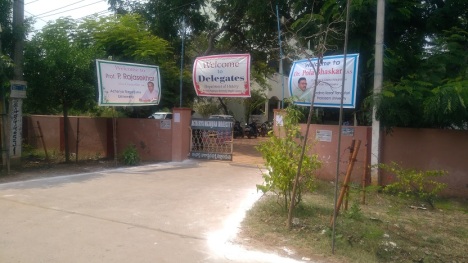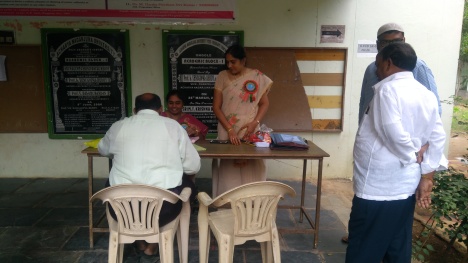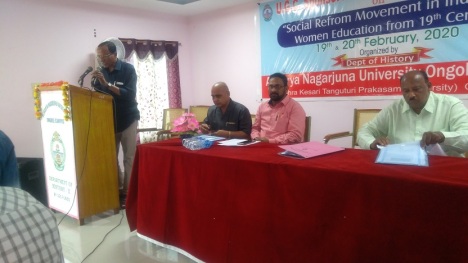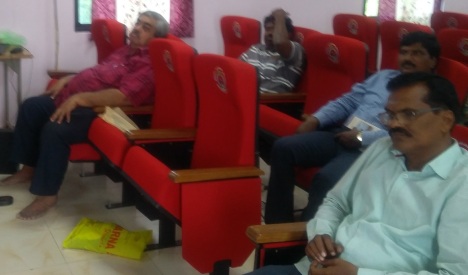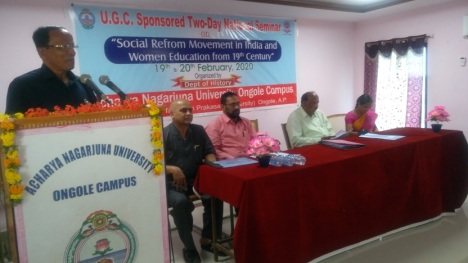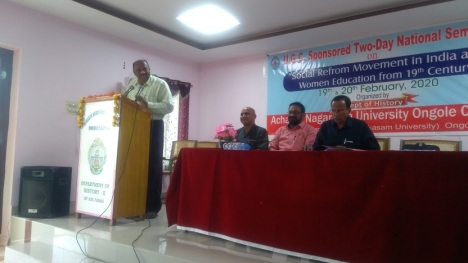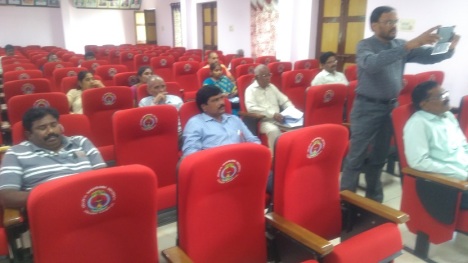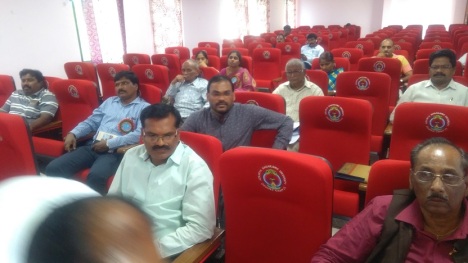Social Reform Movement In India and Women Education from 19th Century – UGC seminar held at the Ongole campus of the Sri Acharya Nagarjuna University [2]
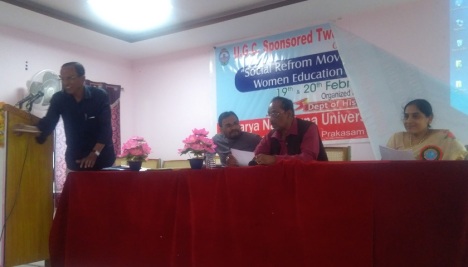
Mahima Dharma / movement and its misinterpretation suppressing other facts: In the second session headed by Prof Naidu, three papers were presented – Anjaiah, Pareswar Sahu and …..Anjaiah talked about the women education of the local AP areas. Pareswar Sahu dwelt upon the Mahima Dharma that teaches belief in a single God (parambrahma or the supreme-soul who is formless and omnipresent) named Alekha. Mahima Dharma became a powerful force for liberation in India because, as a traditional Indian religion, it stood uncompromising in its rejection of the caste system. Sri Bhima Bhoi, an initiate and ardent disciple of Mahima Swami who collected, disseminated and created bhajans from the teachings of Mahima Swamy, was a Khond from Odisha. The distinct and original teachings of Mahima Dharma are often conveyed using terms that may have an unrelated meaning in other Indian religious traditions. This has led scholars to see similarities between Mahima Dharma and, variously, the traditions of “crypto-Buddhism”, Panchashakas, Jainism and Tantra . Adherents reject idol worship as well as the Advaita tradition of Vaishnavism. Charity through the provision of food for those in need is an essential part of Mahima Dharma.
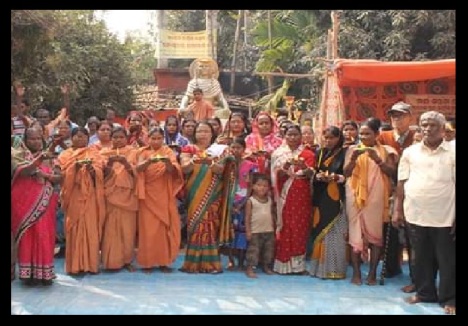
Why Mahima cult should oppose Idol-worship?: However, when I asked how “Idol worship” could solve the problem or opposed for the purpose, he could not explain, but was repeating general points of the Mahima Dharma. I pointed out that had the idil-worship been so bad or sinned, more and more idols and temples would not have come up in India and as well as in other countries. He was arguing that the Orissa tribals were not idol-worshippers. When I started giving examples, he kept quiet. I do not know why he was presenting details partially, suppressing some and pointing out others. There should be consistency in arguing through the facts presented. One cannot take two or different stands at different occasions, just for argument. In fact, there have been many papers and books published on the subject[1]. Incidentally, he avoided many important points about the movement that worked against the Puri Jagannath temple aiding and abetting the colonial forces and also turning against them, at another stage. Researchers have pointed out that many counter traditions and critiques like the Mahima Dharma did emerge, but ultimately these were absorbed into the broad fold of the Jagannath cult[2].
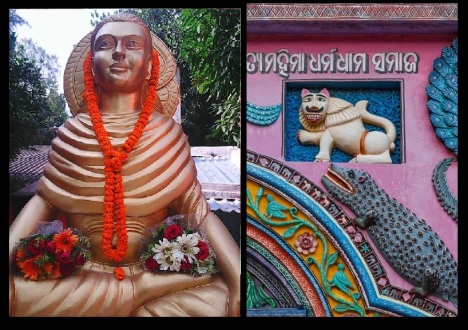
Pandita Ramabai and the Christian Missionaries: The third session was chaired by Dr Gangaiah and Prof Naidu and Reddy presented their papers. Of course, Gangaiah also presented his paper briefly. He wondered for Europe the modern period starts from 1483, whereas, for India, It starts from 1857. As he is going to attend one international conference at Eluru, he wanted to share some of the points here. In 1852, the Hunter Commission opened education to women. Zenana Missionary played a key role in educating Indian women. Though T. B. Macaulay was blamed for his attempt to create slaves in the form oof clerks by giving English education, he is responsible for opening up an avenue for education in India in 1835.
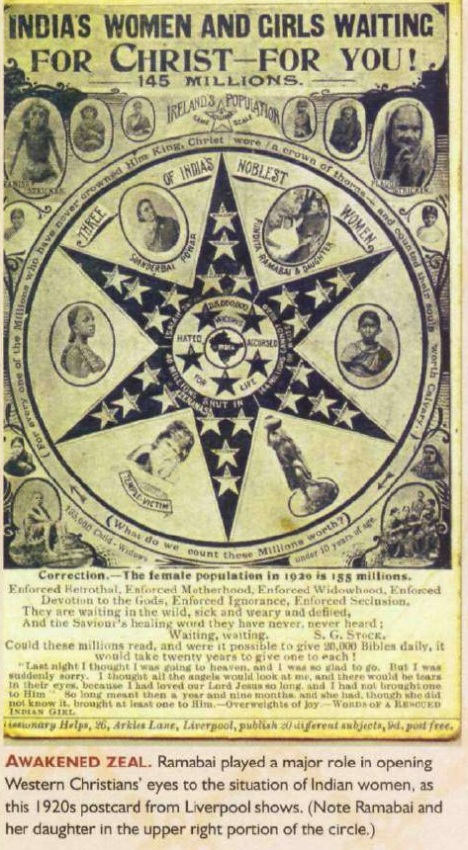
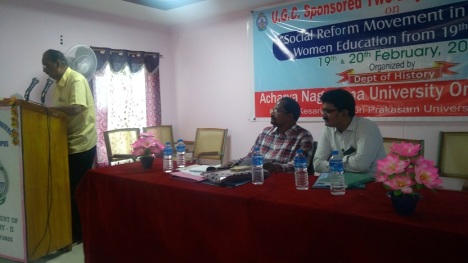
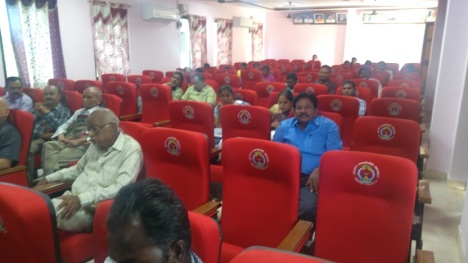
Prof Naidu presented a paper on “Pandita Ramabai,” claiming based on the rare documents that he found at the United Theological College, Bangalore, but most of the details have already been available in the public domain. In fact, many research papers are available in the internet sites as could be noted from “Google scholar.” About “why she was not excommunicated while Rajaram Mohan Roy was” and “Inculturation,” he responded with the single word answer “no”. Gangaiah also raised the issue that the Christian missionaries did not do much for education. But, Naidu was differentiating the different denominations. I wanted to talk with Dr Gangaiah, but, he had gone already. The morning I saw him at a house when the car went there to pick up, but, he was not ready. The Orissa researcher had also already left, with whom also, I wanted to discuss about the “Mahima dharma”. I wondered though only 40 registered and there were 14 paper presenters, most of them had been in a hurry in presenting a paper, getting a certificate and leaving immediately. I do not want as to why they could not listen to others, but, expect others to listen to their papers!
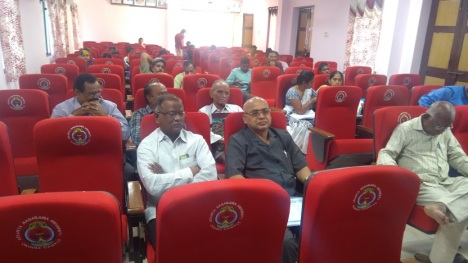
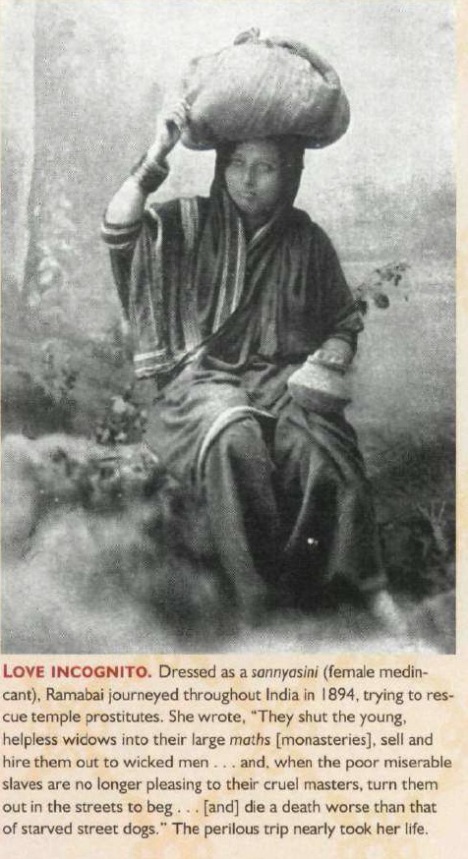
The second-day proceedings – 20-02-2020: On 20th second day, in the first session, headed by Dr B. Ramachandra Reddy, K. V. Ramakrishna Rao, Dr Samba Siva Reddy and Alladi Mahalakshmi, presented their papers. I presented my paper, “The Myth and Reality of Social Reform Movement in India and Women Education from the 19th Century,” wit PPT. Generally, about the social reformation of colonial India, historians and researchers have been repeating the points that the British banned Sati, child-marriage, etc., introduced the Widow Remarriage Act etc., and so on, without going to the details of the other side.

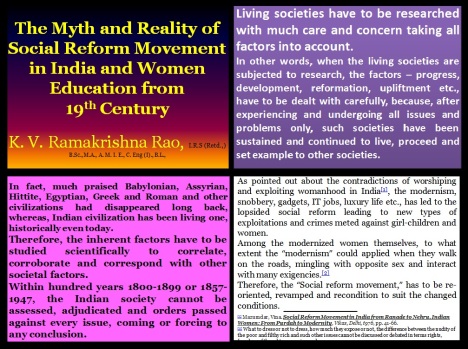
I concluded with the following points:
- The subject matter has been subjective, though aimed at an objective, however, objectivity also affects historians.
- The “Social Reform Movement in India and Women Education from 19th Century” cannot be analyzed exclusively based on the colonial documents, as they have been one-sided, biased and prejudiced, and therefore, the other evidences of Indians have to be taken into account to get a balanced, realistic and objective view.
- With the cause and effect and other logical processes, from the results, the facts could be assessed, determined and judged.
- The East India Company and the British Indian rulers, administrators and the British Government may or may not open up with all their documents, so that Indian researchers could come out with 100% perfect factual report about the issue.
- Indian intellectuals had responded to social reform by all means, by changing their pattern. Associations, conferences and meeting were conducted to create awareness among the Indian women[3]. Their immediate response through such activities prove the awareness among them.
- Annie Besant[4] urged Indians should compete with westerners in the aspects of education to women, going to other countries and so on.
- However, in spite of all efforts and modernization, even today, the highly scientific and technical atmosphere, the exploitation of women has reached, different arena.
- As pointed out about the contradictions of worshipping and exploiting womanhood in India[5], the modernism, snobbery, gadgets, IT jobs, luxury life etc., has led to the lopsided social reform leading to new types of exploitations and crimes meted against girl-children and women.
- Among the modernized women themselves, to what extent the “modernism” could be applied when they walk on the roads, mingling with the opposite sex and interact with many exigencies.[6] Therefore, the “Social reform movement,” has to be re-oriented, revamped and recondition to suit the changed conditions.
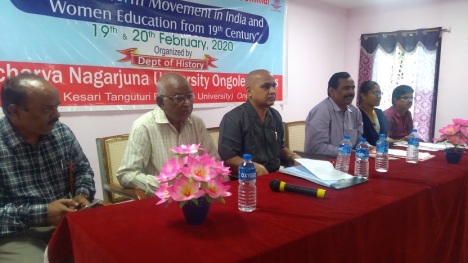
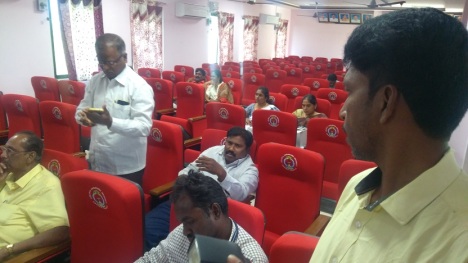
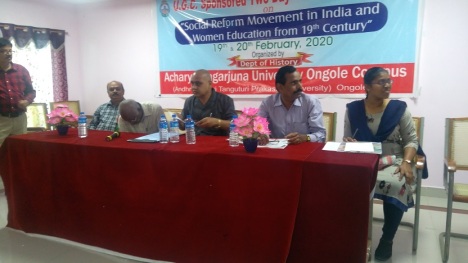
The next session was chaired by Dr Sudharshan with the three paper presenters – Prof Venkateswarara Rao presented a paper on Social movements of Nellore Districts, ….. and a lady on Durgabhai Deshmukh.
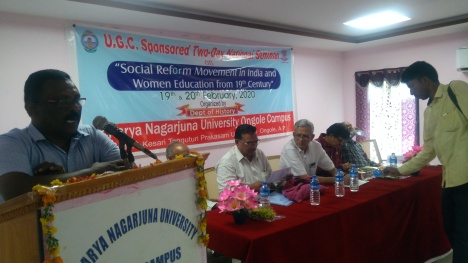
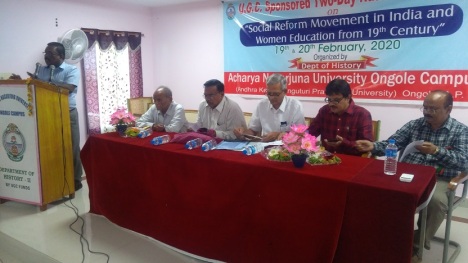
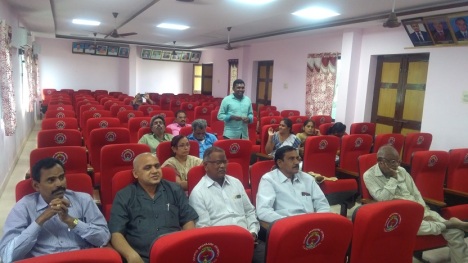
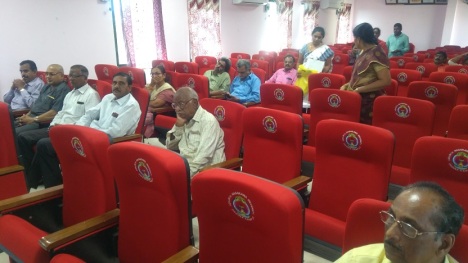
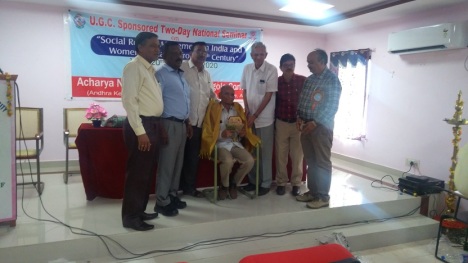
Old Guru was honoured: The valedictory function was also carried on as a formality as only 10 delegates were there. As already mentioned, dozen paper presenters had already left. After that, the valedictory function was held. Prof A. R. Rammachandra Reddy gave an emotional talk about his association with many scholars, colleagues and students who became professors and HOD now. Prof A. R. Ramachandra Reddy was honoured by their collogues and students. Thus, the seminar was over. As my train was at 6.00 pm, I returned to the room, packed up and checked out. Sri Madhusudhana Rao was also there, we caught an auto and went to the railway station, he proceeded to the bus-stand. I went to the platform no.3 and waited for the “Jansathabthi.” Here, for the convenience of the passengers, an elevator and a lift have been provided so that the elders and others who have leg/knee problem can conveniently use them, without climbing steps. This has been an important development by the railways to bring facility to the public. Thus, my visit to Ongole was over and expecting another to come again and meet all the friends!
© K. V. Ramakrishna Rao
23-02-2020
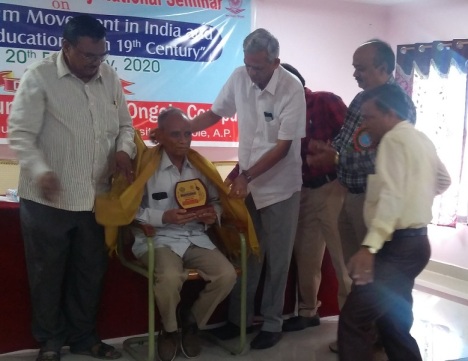
[1] Beltz, Johannes. Contested Authorities, Disputed Centres and Rejected Norms: Situating Mahima Dharma in its Regional Diversity, in Periphery and centre: studies in Orissan history, religion and anthropology, 2002.
[2] A Eschmann, Mahima Dharma: An Autochthonous Hindu Reform Movement’ in A Eschmann et al (eds), The Cult of Jagannath, op cit. Also see Subhakanta Behera (1997): ‘Jagannath and Alekh: A Study in Juxtaposition’, Economic and Political Weekly, Vol XXXII, Nos 33 and 34, August 16-23, pp 2096-97.
[3] Chintamani, Chirravoori Yajneswara, ed. Indian Social Reform: Being a Collection of Essays, Addresses, Speeches, &c., with an Appendix. Minerva Press, 1901
[4] Annie Besant, Wake up India – A Plea for Social Reform, TheosophicalPublishing House, Madras, 1913.
[5] Mazumdar, Vina. Social Reform Movement in India from Ranade to Nehru. Indian Women: From Purdah to Modernity, Vikas, Delhi, t976, pp. 41-66.
[6] What to dress or not to dress, how much they expose or not, the difference between the nudity of the poor and filthy rich and such other issues cannot be discussed or debated in terms rights, freedom of thought, expression and so on.
Filed under: ambedkar, anti-brahman, anti-brahmin, anti-hindu, anti-india, blind-belief, censor, censorship, colonial, colony, culture, dalit, deshmuk, female, female infanticide, female-worker, feminist, freedom of expression, freedom of press, freedom of thought, gender, Hindu, Hindu religion, Hinduism, historicity, historiography, history, Jesus, myth, myth promoted, nationalism, nationality, non-brahmin, non-vegetarian, not Hindu, prostitution, purdah, Ramakrishna Rao, research, Revering Womanhood, servant-maid, sex, sexploitation, slave, slavery, social justice, Social Reform Movement, Social Reform Movement In India, social reformation, Social science, Status of women Education, telangana, tradition, tribal, Uplift of women, Upliftment of Dalits, Veda, white prostitution, women, zenana | Tagged: british, christian, colonial press, colonial rule, colonialism, colony, conversion, dalit, dalit liberation, education, female, female infanticide, indian history, nagarjuna University, ongole, pandita ramabai, ramabai, reformation movement, Revering Womanhood, right to education, Role of Reformers, social refomation, social reform, Social Reform Movement, Social Reform Movement In India, Status of women Education, Upliftment of Dalits, woman right, women education | Leave a comment »


